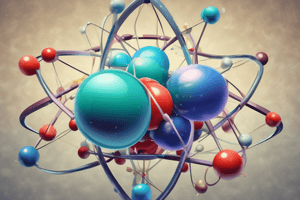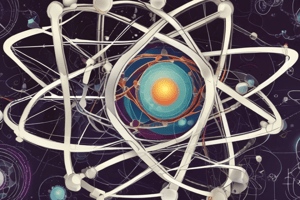Podcast
Questions and Answers
What is the main limitation of Dalton's Atomic Model?
What is the main limitation of Dalton's Atomic Model?
It does not account for subatomic particles or electron arrangement
In Rutherford's Nuclear Model, what is the composition of the nucleus?
In Rutherford's Nuclear Model, what is the composition of the nucleus?
Protons and neutrons
What is the key feature of Bohr's Atomic Model?
What is the key feature of Bohr's Atomic Model?
Electrons in specific energy levels (shells) around the nucleus
What is the primary purpose of ball-and-stick models in chemistry?
What is the primary purpose of ball-and-stick models in chemistry?
What do electron density models represent in a molecule?
What do electron density models represent in a molecule?
How do molecular models simplify complex molecular structures?
How do molecular models simplify complex molecular structures?
What is the benefit of using models to represent atomic and molecular structure?
What is the benefit of using models to represent atomic and molecular structure?
What do space-filling models show about molecular structure?
What do space-filling models show about molecular structure?
What do balls and sticks represent in a ball-and-stick molecular model?
What do balls and sticks represent in a ball-and-stick molecular model?
How do molecular models help predict the polarity of a molecule?
How do molecular models help predict the polarity of a molecule?
What characteristic of a molecule can be influenced by its shape and size?
What characteristic of a molecule can be influenced by its shape and size?
What can molecular models be used to highlight in a molecule?
What can molecular models be used to highlight in a molecule?
What is the primary advantage of using space-filling models?
What is the primary advantage of using space-filling models?
How can molecular models be used to compare and contrast different molecules?
How can molecular models be used to compare and contrast different molecules?
What can be predicted from the arrangement of atoms in a molecular model?
What can be predicted from the arrangement of atoms in a molecular model?
What aspect of molecular reactivity can be influenced by the arrangement of atoms?
What aspect of molecular reactivity can be influenced by the arrangement of atoms?
Flashcards are hidden until you start studying
Study Notes
Models of Atomic Structure
- Atomic Models: Representations of the structure of atoms, helping to visualize and understand their composition.
- Dalton's Atomic Model:
- Proposed by John Dalton in 1803
- Assumes atoms are indivisible, spherical, and have a central nucleus
- Does not account for subatomic particles or electron arrangement
- Rutherford's Nuclear Model:
- Proposed by Ernest Rutherford in 1911
- Describes the atom as having a small, dense nucleus (protons and neutrons) surrounded by electrons
- Does not explain electron arrangement or energy levels
- Bohr's Atomic Model:
- Proposed by Niels Bohr in 1913
- Describes electrons in specific energy levels (shells) around the nucleus
- Electrons jump to higher energy levels when absorbing energy, and drop to lower levels when releasing energy
Models of Molecular Structure
- Molecular Models: Representations of the structure of molecules, showing the arrangement of atoms.
- Ball-and-Stick Models:
- Use balls to represent atoms and sticks to represent bonds
- Show the 3D arrangement of atoms in a molecule
- Help visualize molecular shape and bond angles
- Space-Filling Models:
- Use spheres to represent atoms, with the size of each sphere proportional to the atom's size
- Show how atoms occupy space in a molecule
- Help visualize molecular shape and volume
- Electron Density Models:
- Use contour lines or surfaces to represent the distribution of electrons in a molecule
- Show the probability of finding electrons in a particular region
- Help visualize molecular orbitals and electron distribution
Importance of Models in Chemistry
- Simplification: Models simplify complex atomic and molecular structures, making them easier to understand and work with.
- Visualization: Models help visualize the arrangement of atoms and electrons, facilitating understanding of chemical properties and reactions.
- Prediction: Models allow chemists to make predictions about the behavior of atoms and molecules, guiding experimental design and interpretation.
Models of Atomic Structure
- Atomic models represent the structure of atoms, helping to visualize and understand their composition.
- Dalton's Atomic Model (1803) proposes that atoms are:
- Indivisible
- Spherical
- Have a central nucleus
- (Does not account for subatomic particles or electron arrangement)
- Rutherford's Nuclear Model (1911) describes the atom as having:
- A small, dense nucleus (protons and neutrons)
- Electrons surrounding the nucleus
- (Does not explain electron arrangement or energy levels)
- Bohr's Atomic Model (1913) describes electrons in:
- Specific energy levels (shells) around the nucleus
- Electrons jump to higher energy levels when absorbing energy
- Electrons drop to lower energy levels when releasing energy
Models of Molecular Structure
- Molecular models represent the structure of molecules, showing the arrangement of atoms.
- Ball-and-Stick Models:
- Use balls to represent atoms
- Use sticks to represent bonds
- Show the 3D arrangement of atoms in a molecule
- Help visualize molecular shape and bond angles
- Space-Filling Models:
- Use spheres to represent atoms (proportional to atom size)
- Show how atoms occupy space in a molecule
- Help visualize molecular shape and volume
- Electron Density Models:
- Use contour lines or surfaces to represent electron distribution
- Show the probability of finding electrons in a particular region
- Help visualize molecular orbitals and electron distribution
Importance of Models in Chemistry
- Models simplify complex atomic and molecular structures, making them easier to understand and work with.
- Models help visualize the arrangement of atoms and electrons, facilitating understanding of chemical properties and reactions.
- Models allow chemists to make predictions about the behavior of atoms and molecules, guiding experimental design and interpretation.
Molecular Models
Atom Arrangement
- Molecular models show how atoms are arranged in a molecule
- Atoms are represented by spheres or balls, with their relative sizes and positions showing their relationships
- Bonding between atoms is represented by sticks or rods, indicating chemical bonds
Types of Molecular Models
- Ball-and-stick models: atoms are balls, bonds are sticks
- Space-filling models: atoms are overlapping spheres, showing molecular shape and volume
Compound Characteristics
- Molecular models help predict and understand:
- Shape and size: overall shape and size of a molecule
- Polarity: atom arrangement indicates polarity
- Solubility: shape and size affect solubility in different solvents
- Reactivity: atom arrangement influences reactivity
Using Models to Represent Structure
- Molecular models represent molecular structure in a visual way
- They help:
- Illustrate molecular shape and size: understanding physical properties
- Show bond angles and distances: predicting molecular properties and reactivity
- Highlight functional groups: identifying groups responsible for properties and reactivity
- Compare and contrast different molecules: understanding similarities and differences
Studying That Suits You
Use AI to generate personalized quizzes and flashcards to suit your learning preferences.



